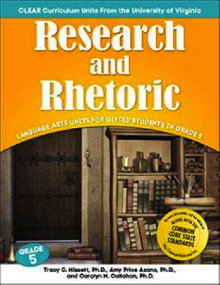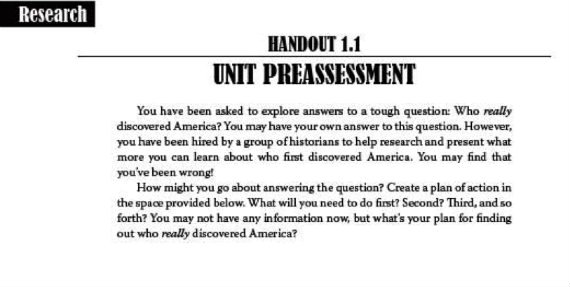Best Teaching Practices for Research & Rhetoric
Research and Rhetoric: Language arts units for gifted students in grade 5
By Tracy C. Missett, Ph.D, Amy Price Azano, Ph.D, and Carolyn M. Callahan, Ph.D.
(Prufrock Press, 2016 – Learn more)

At first, I was apprehensive about reviewing Research and Rhetoric: Language arts units for gifted students in grade 5. I had never heard about the CLEAR Curriculum Model and was not sure whether I would be able to apply the information from the book into my own classroom teaching practices.
However, after reading the first page, I realized that this book was about “best teaching practices.” Although the CLEAR curriculum is geared towards gifted students, the concepts reflected in the book are what should be occurring in all classrooms. The CLEAR Curriculum Model is based on five foundation elements, which should be present in every learning environment:
- Continual formative assessment
- Clear learning goals
- Data driven learning experiences
- Authentic products, and
- Rich curriculum

An easy-to-follow process
If you are apprehensive about how to begin using the book, relax. The authors walk you through the entire process with carefully scripted and well-researched lessons. However, as any good teacher knows, they are just a framework for your teaching. The authors provide hints and guidelines to differentiate the teaching to meet your students’ needs.
Before you attempt to decipher the units, take the time to examine the features of the book. There is an extensive explanation of the book’s text features. The broad overview of each unit gives in-depth details of what should be occurring in the classroom, including the classroom environment, management, and ongoing assessments.
Throughout the book are a series of icons which aid the teacher in implementing the lessons, such as whether the activity is whole class, independent, small group work or type of differentiation readiness, interest, learning profile. The sidebars on each page give the reader notes and hints of what to expect and consider in the classroom, along with sample charts of what to do when a student is struggling with the concept.
Each unit begins with an overview of the big ideas, learning objectives and unit outline, and targeted skills. I found the structure of the units helpful from the beginning to the end. The pre-assessment at the beginning of each unit helped me understand what was expected in the unit and how I could use that to differentiate my teaching. The final tasks were authentic and challenging, and paralleled what an expert in the field might experience.
Standards based units
Each book in the series has two grade level language arts units based on the CLEAR model. I was very impressed with the quality of the units and the Common Core alignment. Students are encouraged to challenge their literacy skills, become critical thinkers, and reach out beyond the text to consider the implications of the topics they are learning. What was emphasized throughout was to promote deeper thinking by taking educational risks.
The fifth grade unit, “Exploration and Communication: A Researcher’s Journey,” was created to assist students in further developing appropriate research skills through the job of a researcher as an explorer. This metaphor was a perfect way to engage the students in exploring how to frame research questions, search, organize and evaluate the texts they are reading using the Big6 research process (Eisenber and Berkowitz, 1987).
In this model, students conduct their own research study and present findings at a research gala. (I just love their idea of having a “gala.” It provides an aura of professionalism and excitement to the students.) Even though I am a fourth grade teacher, I was able to use many of the ideas, forms, and lessons in our nonfiction research genre study.
The second unit, “Aristotle’s Rhetoric: Learning the Art of Persuasion,” was designed to help students become more proficient in developing the ability to persuade others through their writing, reading, listening, and speaking skills. I was particularly interested in how the authors approached this unit of study. Honestly, just the title of the unit was overwhelming to me!
Rhetoric: beyond responding to speeches
Actively engaging students in the art of rhetoric isn’t a simple task. It is more than just reading and watching speeches. It is learning how to become an effective speaker using strategies that will appeal to the audience. Students are encouraged to engage in vocal warm up activities such as practicing tongue twisters or using stretching activities they may have learned in extracurricular activities such as dance or yoga.
There are 13 well-designed lesson plans that guide the teacher as she/he teaches students how to critically analyze persuasive reading, writing, and speaking. The lesson plans also offer opportunities for students to actively engage in argumentative strategies that reflect their interests and experiences. The final project is an “Ode to Aristotle Rhetoric Gala.”
Ideas to implement
This book reminded me of an all-inclusive trip to a resort. Everything and anything you need to teach students about research and public speaking is included. There aren’t any “hidden charges.” Each lesson began with the materials needed, objectives, sequence of activities, formative assessments, handouts galore, ideas for homework, and digital resources.
I found myself jotting down many of the hints to use in my regular education classes, such as after brainstorming research questions, then guiding students to highlight in three colors: green for questions that are open ended and good to research, pink for questions inappropriate to research, yellow for questions students are unsure of or there is a disagreement about.
The authors have created a must-read for teachers who have been wondering how to foster creativity and increase student engagement while teaching research and persuasive writing. It is a book that guides teachers to encourage good research practices which are critical for our students to succeed in the 21st century. It’s a must read for teachers who want to develop responsible learners and will be useful across the student spectrum.
Linda Biondi is a fourth grade teacher at Pond Road Middle School in Robbinsville, NJ, and a long-time Morning Meeting practitioner. She’s also the recipient of several educational grants, a Teacher Consultant with the National Writing Project and a participant on the NJ Department of Education Teacher Advisory Panel. Linda participates in ECET2 Celebrate Teaching which has posted an interview with her.


































